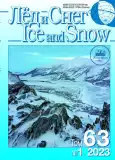Решение одномерной задачи Стефана с двумя фазовыми границами на примере моделирования замерзания воды в ледниковой трещине
- Авторы: Попов С.В.1,2,3
-
Учреждения:
- Полярная морская геологоразведочная экспедиция
- Санкт-Петербургский государственный университет
- Институт мерзлотоведения им. П.И. Мельникова СО РАН
- Выпуск: Том 63, № 1 (2023)
- Страницы: 130-140
- Раздел: Прикладные проблемы
- URL: https://bakhtiniada.ru/2076-6734/article/view/137485
- DOI: https://doi.org/10.31857/S2076673423010131
- EDN: https://elibrary.ru/MARCFM
- ID: 137485
Цитировать
Полный текст
Аннотация
Представлено численное решение одномерной задачи Стефана с двумя фазовыми границами в виде конечно-разностных схем, реализованных на неравномерной сетке. Уравнения записаны в наиболее общей форме, то есть включают в себя не только кондуктивный, но также конвективный и диссипативный члены. В качестве примера выполнено оценочное моделирование процесса замерзания трещины в леднике, заполненной водой. Получено, что для ледников с температурой ниже –5°C время замерзания 30-сантиметровой трещины составляет менее трёх месяцев.
Об авторах
С. В. Попов
Полярная морская геологоразведочная экспедиция; Санкт-Петербургский государственный университет; Институт мерзлотоведения им. П.И. Мельникова СО РАН
Автор, ответственный за переписку.
Email: spopov67@yandex.ru
Россия, Санкт-Петербург; Россия, Санкт-Петербург; Россия, Якутск
Список литературы
- Глазовский А.Ф., Мачерет Ю.Я. Вода в ледниках. Методы и результаты геофизических и дистанционных исследований. М.: ГЕОС, 2014. 528 с.
- Казко Г.В., Саватюгин Л.М., Сократова И.Н. Моделирование циркуляции воды в антарктическом подледниковом озере Восток // Лёд и Снег. 2012. № 4. С. 86–91.https://doi.org/10.15356/2076-6734-2012-4-86-91
- Краслоу Г., Едгер Д. Теплопроводность твёрдых тел. М.: Наука, 1964. 488 с.
- Кольцова Э., Скичко А., Женса А. Численные методы решения уравнений математической физики и химии. М.: Юрайт, 2020. 220 с.
- Кузнецов Г.В., Шеремет М.А. Разностные методы решения задач теплопроводности: учебное пособие. Томск: Изд-во ТПУ, 2007. 172 с.
- Патерсон У.С.Б. Физика ледников. М.: Мир, 1984. 472 с.
- Попов С.В., Кашкевич М.П., Боронина А.С. Состояние взлетно-посадочной полосы станции Новолазаревская (Восточная Антарктида) и оценка безопасности её эксплуатации по данным исследований 2021 г. // Лёд и Снег. 2022. Т. 62. № 4. С. 621–636.
- Попов С.В., Поляков С.П., Пряхин С.С., Мартьянов В.Л., Лукин В.В. Строение верхней части ледника в районе планируемой взлетно-посадочной полосы станции Мирный, Восточная Антарктида (по материалам работ 2014/15 года) // Криосфера Земли. 2017. Т. XXI. № 1. С. 73–84.
- Рыбак О.О., Рыбак Е.А. Алгоритм решения системы уравнений течения льда в трёхмерной математической модели // Известия высших учебных заведений. Северо-Кавказский регион. Естественные науки. 2010. № 6. С. 117–121.
- Самарский А.А. Теория разносных схем. М.: Наука, 1977. 656 с.
- Смирнов В.И. Курс высшей математики. Т. 2. М.: Наука, 1974. 656 с.
- Тихонов А.Н., Самарский А.А. Уравнения математической физики. М.: Наука, 1977. 736 с.
- Alley R.B., Dupont T.K., Parizek B.R., Anandakrishnan S. Access of surface meltwater to beds of sub-freezing glaciers: preliminary insights // Annals of Glaciology. 2005. V. 40. P. 8–14.
- Budd W.F. The dynamics of ice masses. ANARE Sci. Rep. Publ. 1969. V. 108, 212 p.
- Greve R. A continuum-mechanical formulation for shallow polythermal ice sheets // Philos. Transaction Royal Society. London, 1997. V. 355. № 1726. P. 921–974.
- Greve R., Blatter H. Dynamics of ice sheets and glaciers. Springer Science & Business Media, 2009. 300 p.
- Huybrechts P. The Antarctic ice sheet and environmental change: a three-dimensional modelling study // Ber. Polarforsch. 1992. V. 99. 244 p.
- Nye J.F. Water flow in glaciers: jökulhlaups, tunnels, and veins // Journ. of Glaciology. 1976. V. 17. № 76. P. 181–207.
- Pattyn F. A new three-dimensional higher-order thermomechanical ice sheet model: Basic sensitivity, ice stream development, and ice flow across subglacial lakes // Journ. of Geophys. Research. 2003. V. 108. № B8. 2382 p.
- Poinar K., Joughin I., Lilien D., Brucker L., Kehrl L., Nowicki S. Drainage of Southeast Greenland Firn Aquifer Water through Crevasses to the Bed // Journ. of Front. Earth Sci. 2017. V. 5. 5 p. https://doi.org/10.3389/feart.2017.00005
- Thoma M., Grosfeld K., Mayer C. Modelling mixing and circulation in subglacial Lake Vostok, Antarctica // Ocean Dynamics. 2007. V. 57. № 6. P. 531–540.
- van der Veen C.J. Fracture propagation as means of rapidly transferring surface meltwater to the base of glaciers // Geophys. Research Letters. 2007. № 34. L01501. https://doi.org/10.1029/2006GL028385
Дополнительные файлы















